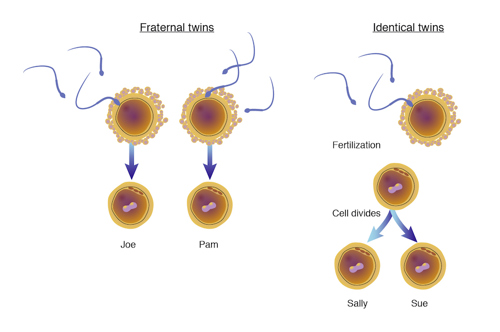
What are the genetics behind tone deafness?
May 22, 2014

- Related Topics:
- Classical genetics,
- Complex traits,
- Gene expression,
- Genetic variation
An undergraduate from the Netherlands asks:
"What are the genetics behind congenital amusia (tone deafness)?"
Scientists know that genetics is important in tone deafness (also known as congenital amusia). They’ve done some twin and family studies that show that.
They also think that the genes involved are pretty specific to not being able to tell when a wrong note is played in a song. This is because being tone deaf isn’t associated with any other trait. For example, you can be tone deaf but have good hearing, a sense of rhythm and a good memory. You just can’t tell one pitch from another very well.1
Studies also show that genetics are not the only factor that determines whether you are tone deaf. Listening to a lot of music, playing an instrument, or singing can help people get better at telling wrong notes apart.2
What scientists haven’t figured out yet are the actual genes that are involved. Nor can they easily predict the chances that a tone deaf parent will have a tone deaf child or that two parents that aren’t tone deaf will have a child that is. All we can say is that if tone deafness runs in your family, then you are more likely to end up with it as well.1
What I thought I’d do for the rest of the answer is go a bit deeper into some of the evidence that genetics is involved in tone deafness. Then I’ll end by showing that having perfect pitch is probably not simply the opposite of tone deafness.

Twins and Families
A study looking at tone deafness in large families found that people who are tone deaf tend to have relatives who are also tone deaf. The authors of the study concluded that tone deafness is largely determined by genetics.1
The fact that tone deafness runs in families could have other explanations than just genetics. For example, consider a family that lives near a toxic waste site. Many family members may get cancer, but shared genes are not the reason for the cancer-- the toxic waste site is. Families tend to share houses and lifestyles as well as genes.
To get around this problem, researchers often turn to fraternal and identical twins. Identical twins share 100% of their DNA, while fraternal twins only share about half of their DNA. Both types of twins usually grow up together and share most of the same environment.

If a trait is determined completely by genetics, identical twins should more often share that trait compared to fraternal twins. This is because they have the same DNA and fraternal twins only share half their DNA.
On the other hand, if a trait is determined mostly by the environment, both types of twins should be equally similar to each other. This is because they share pretty close to the same environments.
Researchers used a “twin study” to look into the genetics of tone deafness. They measured the ability of both identical and fraternal twins to pick out wrong notes in popular songs.3
They found that identical twins were more likely to both be tone deaf but it wasn’t 100%. There were plenty of cases where one identical twin in a pair was tone deaf and the other wasn’t.
With some number crunching the researchers concluded that between 71 and 80% of tone deafness can be explained by genetics. The remaining percentage is likely due to things like how much the different families listened to music or if the kids took music classes.
This isn’t all the researchers learned from this twin study. They were also able to learn a little about how the genetics of tone deafness works.
Tone Deafness is Additive
Traits like eye color or tone deafness can work in lots of different ways. Sometimes one trait dominates over a recessive one. This is what happens with eye color—dominant brown wins out over recessive blue.
Sometimes traits are additive or sort of blend together. This is like when a red flower and a white flower give pink flowers.
And sometimes there is a continuum of traits. Height is an example of a trait like this. There is a wide range of possible heights from short to tall.
The researchers found that tone deafness is more like pink flowers or height than it is like eye color in that people can be more or less tone deaf. For example, one person may be able to pick out wrong notes in a song one out of three times, while someone else only one out of five times.
There are a couple of ways a trait can end up additive like this. One is if lots of genes all work together to give a final trait.
For tone deafness, many genes might be involved in helping us hear notes correctly. If you have an error in a few of those genes, you may be somewhat tone deaf. If many of those genes have errors, then you’ll be more tone deaf.
A trait can still be additive even if only one gene is involved. This is because people have two copies of every gene and these two copies can be different. These different versions of the same gene are called alleles.
In our flower example, the color gene comes in a red version and a white one. If a flower has a red allele and white allele, they end up pink. The colors blend together.
For tone deafness, we can imagine a version of a gene that lets you tell pitch and one that doesn’t. If both alleles are the one that lets you tell one pitch from another, then you are really good at it. If you have one of each you can kind of tell two pitches apart and if you have two tone deaf alleles then you are really bad at it.
Of course, most of us aren’t perfect at telling one pitch from another. But surprisingly, some people are.

Not the Opposite of Perfect Pitch
Some people can instantly recognize a pitch and identify what note it is. This ability is called “perfect pitch.”
Perfect pitch isn’t as strongly genetic as tone deafness. What is very important for perfect pitch is early musical training.4
Like with foreign languages, perfect pitch is much easier to learn for children than for adults. However, not every kid that goes to music class will learn perfect pitch. Genes still play a role.
The genes that are important for learning perfect pitch are not all the same genes that are important for tone deafness. Remember when I said tone deafness wasn’t associated with much of anything else? The same is not true for perfect pitch. People with perfect pitch often have a better memory than most people.
So while some of the genes may be the same, tone deafness and perfect pitch are not different sides of the same coin. They are separate traits.
Read More:

Author: Alicia Schep
When this answer was published in 2014, Alicia was a Ph.D. candidate in the Department of Genetics, studying the role of nucleosome positioning in gene regulation in Will Greenleaf’s laboratory. She wrote this answer while participating in the Stanford at The Tech program.
 Skip Navigation
Skip Navigation
